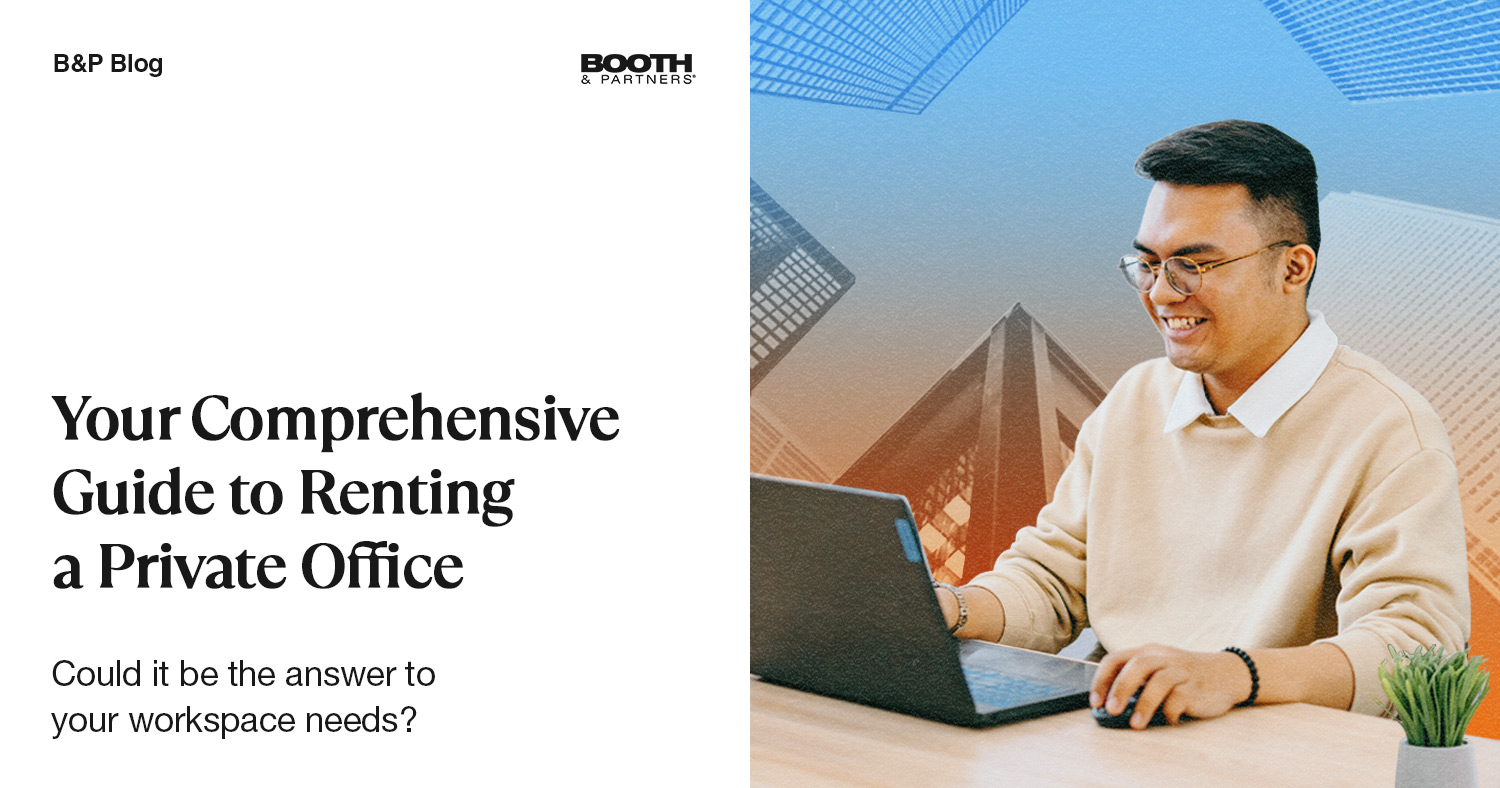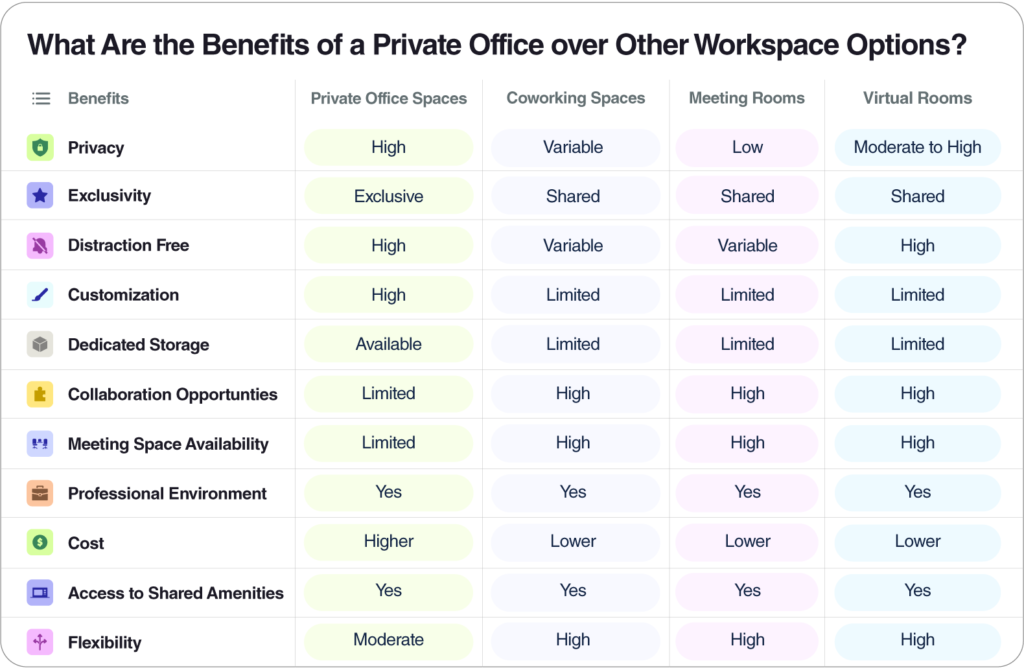Your Comprehensive Guide to Renting a Private Office

In today’s bustling world, where the lines between work and life often blur, finding a dedicated and private space to focus and thrive has become more critical than ever.
Let’s meet John, the founder of a burgeoning startup, facing a challenge familiar to many entrepreneurs — the need for a private office for his small team.
John’s journey began when his team outgrew their cramped coworking space. The constant noise and lack of privacy hindered their ability to concentrate and collaborate effectively. Determined to create an environment that would ignite their creativity and drive, John set out to find a private office.
After an exhaustive search, he stumbled upon a hidden gem—a spacious office nestled in a quiet corner of the city. As he stepped through the door, John felt an instant shift in energy. Gone were the distractions and disruptions that plagued their previous workspace. In this new sanctuary, his team found the focus and tranquility they desperately craved.
If you find yourself in a similar predicament or simply yearn for a workspace that truly aligns with your professional needs, you’ve come to the right place. In this comprehensive guide, we will navigate the intricate world of private office rentals, offering you invaluable insights and tips to help you find the perfect workspace.
What is a Private Office?
A private office refers to a dedicated area within a shared office facility that offers individuals or businesses the option to have their own exclusive workspace while still benefiting from the flexibility and amenities of a larger workspace environment.
Some of the features of a private office may include:
- Exclusive and secure area: Private office spaces provide individuals or teams with their own enclosed area, ensuring privacy and security for their work and belongings.
- Customizable setup: Users can often personalize the layout, furniture, and decor of their private office to suit their preferences and work style.
- Access to shared amenities: While having their own private space, users of private office spaces typically have access to shared amenities within the larger workspace facility. This may include meeting rooms, communal areas, kitchen facilities, and sometimes additional services like receptionist support or administrative assistance.
- Flexible lease terms: Private office spaces usually offer flexible lease options, allowing individuals or businesses to rent the space for short or long durations based on their specific needs. This flexibility is beneficial for startups, freelancers, and small businesses that may require a temporary or flexible workspace solution.
What are the Benefits of a Private Office Over Other Workspace Options?
Here’s a side-by-side comparison table highlighting the benefits of a private office for rent over other workspace options like coworking spaces, meeting rooms, and virtual rooms:

Assessing Your Workspace Requirements: Questions to Ask Before You Rent a Private Office
Assessing your workspace requirements is an important step in choosing the best private office for your needs. Here are some questions you can ask yourself to help evaluate your workspace requirements and secure the best private office for rent:
1. Space and Capacity:
- How many people will be using the private office?
- Do you need a separate office for each individual or a shared space for a team?
- What is the required square footage to accommodate your team comfortably?
2. Amenities and Facilities
- What essential amenities do you need in the private office (desks, chairs, storage, etc.)?
- Are there specific requirements like whiteboards, presentation equipment, or specialized furniture?
- Do you need access to shared facilities such as meeting rooms, kitchen areas, or printing services?
3. Privacy and Distractions
- How important is privacy for your work?
- Will you be engaging in confidential discussions or sensitive tasks that require a high level of privacy?
- Are distractions a concern, and do you need a quiet environment for focused work?
4. Budget and Cost
- What is your budget for the private office?
- Are there any additional costs or fees involved (utilities, maintenance, parking, etc.)?
- How does the cost of a private office compare to other workspace options available to you?
5. Flexibility and Lease Terms:
- How long do you anticipate needing the private office?
- Do you require short-term or long-term lease options?
- Are you open to flexible lease terms or scalability options if your needs change in the future?
6. Location and Accessibility:
- Is the location of the private office convenient for you and your team?
- Are there transportation options and amenities nearby?
- Do you require a specific area or proximity to certain facilities or clients?
7. Company Culture and Image:
- Does the private office align with your company’s culture and values?
- Does it provide a professional and suitable image for your business?
- Is the overall atmosphere and design of the office space important to you?
8. Technology and Connectivity:
- Do you require reliable internet connectivity and IT infrastructure?
- Are there specific technical requirements for your work?
- Does the private office provide the necessary tech support or allow you to set up your own systems?
By answering these questions, you’ll gain a clearer understanding of your workspace requirements and be better equipped to choose the right private office that meets your needs.
How to Evaluate Private Office Space Features and Amenities
Now that you have clearly defined your workspace requirements, it’s time to evaluate office space features and amenities to ensure that your chosen workplace fosters productivity, comfort, and employee satisfaction. In this section, we will delve into the key aspects that are often considered necessary for creating an optimal working environment.
1. Analyzing the Layout, Size, and Design of the Office
The layout, size, and design of an office space play a significant role in creating an efficient and appealing workspace. Here are some points to consider:
- Open Floor Plan vs. Cubicles: Determine whether an open floor plan or cubicles aligns with your company’s work style and culture. Open layouts encourage collaboration, while cubicles provide privacy.
- Space Utilization: Assess the overall square footage and layout efficiency to ensure optimal use of space. Consider the number of employees and departments to ensure everyone has adequate workspace.
- Natural Light and Ventilation: Adequate natural light and ventilation can enhance the productivity and well-being of employees. Look for offices with large windows and good airflow.
- Ergonomics and Accessibility: Take into account the design elements that promote ergonomics and accessibility, such as adjustable desks, ergonomic chairs, and wheelchair accessibility.
2. Considering Essential Amenities:
Essential amenities are the basic necessities that every office space should offer. Evaluate the following amenities before finalizing your decision:
- Reliable Internet Connection: A stable and high-speed Internet connection is vital for most businesses. Check for dedicated broadband connections or fiber optic availability.
- Utilities: Ensure that the office space provides essential utilities like electricity, heating, cooling, and water supply, and evaluate their reliability and cost.
- Parking Facilities: Evaluate the availability of parking spaces for employees and visitors. Consider the convenience, security, and cost of parking options.
- Security Measures: Assess the security measures in place, such as surveillance cameras, access control systems, and on-site security personnel, to protect your employees and assets.
3. Assessing Additional Facilities:
Beyond the essential amenities, some additional facilities can significantly enhance the functionality and employee satisfaction within an office space. Consider the following:
- Meeting Rooms: Evaluate the availability and quality of meeting rooms equipped with necessary audiovisual equipment, whiteboards, and comfortable seating to facilitate productive discussions and presentations.
- Break Rooms and Kitchens: A well-equipped kitchen or break room allows employees to take breaks, socialize, and enjoy meals. Look for facilities that offer amenities like microwaves, refrigerators, and seating areas.
- Recreational Areas: Consider if the office space offers recreational areas like game rooms or lounge spaces. These areas can provide a relaxing environment and encourage employee engagement and creativity.
Understanding Lease Terms and Agreements: What You Need to Know
When you rent a private office space, understanding the terms and agreements is essential to ensure a smooth and successful tenancy. In this section, we will walk you through fundamental aspects of lease agreements that you should be familiar with so you’ll be capable of navigating the leasing process with confidence.
1. Overview of Common Lease Types:
Lease agreements come in various forms, each with its own set of advantages and considerations. Let’s take a closer look at the three most common lease types:
- Full-Service Lease: In a full-service lease, the tenant pays a fixed monthly fee, and the landlord pays all the expenses related to the property. These expenses include utilities (such as electricity and water), maintenance of the building, taxes, insurance, and any costs associated with common areas.
- Modified Gross Lease: Tenants with a modified gross lease are responsible for paying certain items directly, like utilities or janitorial services, in addition to a fixed monthly fee. This means that on top of the regular rent they pay, tenants will have to handle the cost of these specific services themselves. Essentially, a modified gross lease adds extra expenses to the basic rent, and the tenant either takes care of those costs independently or receives a separate bill from the landlord.
- Net Lease: When renting a private office space, tenants with a net lease pay a fixed amount every month as the base rent. However, depending on the specific type of net lease, there are additional monthly fees that the tenant is responsible for. These fees cover their share of property taxes, building insurance, and common area maintenance expenses. There are three types of net leases: single net, double net, and triple net:
- Single net lease. The tenant pays the base rent plus property taxes. This means they contribute towards the property taxes associated with the leased space.
- Double net lease. The tenant pays the base rent, property taxes, and building insurance. Along with the base rent, they also contribute towards the property taxes and insurance costs of the office building.
- Triple net lease. The tenant pays the base rent, property taxes, building insurance, and common area maintenance fees. Common area maintenance fees include costs for shared spaces like hallways, parking lots, and elevators.
2. Examining Lease Duration and Renewal Options:
Examining lease duration and renewal provisions allow you to assess your future needs and evaluate whether the private office space can accommodate your long-term plans. Here’s how you can maximize their advantages so you can maintain stability and control over your workspace.
- Lease Duration: Understand the significance of lease duration and how it can impact your business or living arrangements. Learn about short-term leases, long-term leases, and their implications, helping you choose the right lease duration to align with your goals.
- Renewal Options: Gain insights into lease renewal provisions, including automatic renewal, lease extension negotiations, and the importance of proper documentation. Discover the factors to consider when evaluating lease renewal options and ensure your future leasing needs are adequately addressed.
3. Reviewing Clauses and Obligations:
Lease agreements typically contain various clauses and obligations that define the rights and responsibilities of both parties involved. In this section, we’ll discuss them briefly:
- Essential Clauses: Explore common clauses found in lease agreements, such as rent escalation, maintenance, subletting, and termination clauses. Understand the implications of these clauses and how they can affect your tenancy.
- Tenant and Landlord Obligations: Review the obligations of tenants and landlords, including rent payment, property maintenance, insurance requirements, and dispute resolution. By understanding these obligations, you can ensure a harmonious landlord-tenant relationship and mitigate potential issues.
Expert Tips for Budgeting Rent and Additional Costs
Renting a private office space can be a significant investment for your business. To ensure financial stability and avoid unexpected expenses, it’s a must to create a well-planned budget that encompasses not only the rent but also the additional costs associated with the office space. In this section, we will provide you with expert tips on how to budget for your rent and additional expenses.
Calculating Your Office Space Budget
- Determine Your Maximum Budget: Before starting the search for a private office, evaluate your financial situation and establish a maximum budget. Consider your income, existing expenses, and the amount you are willing to allocate for office space. This will help you set realistic expectations and narrow down your options effectively.
- Assess Your Needs: Assess your requirements in terms of office size, location, amenities, and other essential factors. A thorough understanding of your needs will enable you to allocate your budget more efficiently and prevent overspending on unnecessary features.
- Research Office Rental Prices: Conduct thorough research on the current rental prices for private office spaces in your desired location. Compare different options, take note of the average costs, and factor in any additional charges or fees that may be applicable
Understanding the Breakdown of Costs
- Rent: The direct cost to consider is the monthly rent for the office space. This amount will vary depending on factors such as location, size, amenities, and lease terms. Carefully review the rental agreement to understand the rent structure, payment terms, and any potential increases over time.
- Utilities: Utilities include electricity, water, heating, and cooling expenses. Inquire with the landlord or building management about how these costs are calculated and billed. Consider past utility bills if available to estimate the average monthly expense.
- Maintenance: Maintenance costs cover repairs, cleaning services, and general upkeep of the office space. Some landlords include these costs in the rent, while others charge separately. Clarify maintenance responsibilities and costs before signing the lease to avoid unexpected expenses.
Factoring in Additional Expenses
- Furniture: Depending on the condition of the office space and your specific requirements, you may need to invest in furniture. Consider the cost of desks, chairs, cabinets, and other necessary items. Determine whether you will purchase new furniture or opt for second-hand options to minimize costs.
- Equipment: Assess the equipment you will need for your office, such as computers, printers, telephones, and other essential devices. Research the prices and factor in any maintenance or repair costs associated with the equipment.
- Security: Security measures are essential to protect your office and its assets. Consider the costs of installing security systems, such as surveillance cameras, alarms, and access control systems. Additionally, explore any additional fees associated with building security services.
Concluding the Private Office Space Lease: Essential Actions to Take When Finalizing the Agreement
When it comes to finalizing a private office space lease, there are several essential actions that you should take to guarantee a smooth and successful transition. From reviewing the lease agreement in detail to setting up your office, each step requires careful consideration and attention to detail. Let’s walk you through the key actions you need to take when concluding your office space lease.
1. Reviewing the lease agreement in detail
Before signing any lease agreement, it is crucial to review the document thoroughly. Take the time to read through each clause and provision carefully, paying close attention to the terms, conditions, and obligations outlined within. This includes understanding the lease duration, office rental rates, security deposit requirements, and any additional fees or expenses that may be incurred. If you have any questions or concerns, consult a legal professional experienced in commercial real estate to ensure you fully comprehend the terms before proceeding.
2. Ensuring clarity on terms, conditions, and responsibilities
One of the most critical aspects of concluding an office space lease is ensuring clarity on the terms, conditions, and responsibilities outlined within the agreement. This involves seeking clarification on any ambiguous language or provisions that may lead to confusion later on.
Pay attention to matters such as maintenance responsibilities, insurance requirements, and any restrictions on alterations or modifications to the space. By clarifying these aspects, you can prevent potential disputes and establish a strong foundation for a successful lease term.
3. Signing the lease and understanding the next steps
Once you have reviewed and understood the lease agreement, it is time to sign the document. Ensure that all parties involved, including the landlord or property management representative, sign the lease as well. Make sure to retain a copy of the signed agreement for your records.
After signing, it is essential to discuss and clarify the next steps with the landlord or property management team. This may include arranging for a move-in date, discussing any necessary inspections or repairs, and understanding the procedures for paying rent and other associated costs.
4. Setting Up Your Office
Once the lease is signed and the administrative tasks are complete, it is time to focus on setting up your office. Start by developing a detailed plan for the layout and design of your workspace. Consider factors such as the number of employees, furniture requirements, IT infrastructure, and any specific needs related to your business operations.
Coordinate with vendors or contractors to install necessary utilities, such as electricity, internet, and phone lines. Additionally, establish a timeline for the procurement and installation of office furniture, equipment, and other essentials.
Find the Best Value Private Office Space with Booth & Partner’s Workspace Solutions
Don’t let the complexities of finding and setting up a private office space hinder your business growth. Trust Booth and Partner’s flexible workspace solutions and get access to fully furnished workspaces located at the heart of Makati CBD.
Elevate the way you work with our premium private office spaces designed perfectly for your rapidly-changing workspace needs. Benefit from our concierge support, super fast internet, 24/7 security with biometric access, complimentary access to meeting pods and rooms, 100% backup power, IT support, reliable mail and packaging services, and many more!
Contact us now to schedule a tour and discover the benefits of our flexible office spaces, or go ahead and book your office spaces today!
Discover more about outsourcing and
how you can maximize it for your
business success!
Get a copy of our E-book: Guide to Outsourcing.




